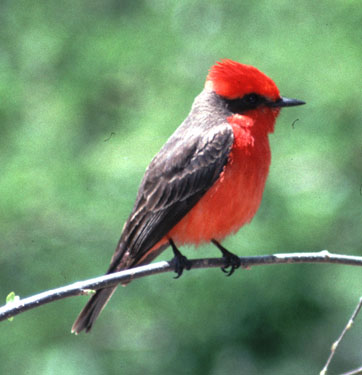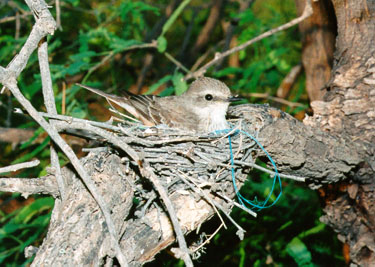Vermilion Flycatcher and Nest With Eggs Photographs and Sound Recording
Photo of Male Vermilion Flycatcher by Earle Robinson
 The hovering flight display of the male Vermilion Flycatcher is one of the sights every birder should make an effort to observe. The male launches vertically from a prominent perch with all his feathers fluffed out or spread. This produces a red puff ball with rapidly beating wings. Climbing vertically, the bird begins to hover at a height that appears to be about 50 - 60 feet (20 meters). Working for all he's worth, he furiously flaps while hovering and then continues the puff ball display while gradually floating down to a tree branch. The target of this display, the female Vermilion Flycatcher, only has a few features in common with the male. One of the shared features is a black mask bar through the eye. Otherwise, the female is mostly a drab brown bird lacking the solid brilliant red color of the male.
The hovering flight display of the male Vermilion Flycatcher is one of the sights every birder should make an effort to observe. The male launches vertically from a prominent perch with all his feathers fluffed out or spread. This produces a red puff ball with rapidly beating wings. Climbing vertically, the bird begins to hover at a height that appears to be about 50 - 60 feet (20 meters). Working for all he's worth, he furiously flaps while hovering and then continues the puff ball display while gradually floating down to a tree branch. The target of this display, the female Vermilion Flycatcher, only has a few features in common with the male. One of the shared features is a black mask bar through the eye. Otherwise, the female is mostly a drab brown bird lacking the solid brilliant red color of the male.
Photo of Female Vermilion Flycatcher by Greg Clark, April 2000, South-Central Arizona
 This is a photograph of the female Vermilion Flycatcher on the nest. Usually, we don't expect to find more nests near cattle water holes or tanks (charcos) compared with other key desert habitats, such as dry washes. However, this nest (like many we have found) was found near a water tank. Because Vermilion Flycatchers have a strong association with water, the tank provided enough food for flycatching and so the birds were able to stay and raise their young. Typically, these flycatchers are seen near water tanks in the winter, or early spring, and then are not found in May because they have left for better habitat. Apparently, if the pond is big enough, and the insects plentiful, even a small pond is sufficient riparian habitat for this species. The blue thread seen in the above photo was added after the photos seen on the next page.
This is a photograph of the female Vermilion Flycatcher on the nest. Usually, we don't expect to find more nests near cattle water holes or tanks (charcos) compared with other key desert habitats, such as dry washes. However, this nest (like many we have found) was found near a water tank. Because Vermilion Flycatchers have a strong association with water, the tank provided enough food for flycatching and so the birds were able to stay and raise their young. Typically, these flycatchers are seen near water tanks in the winter, or early spring, and then are not found in May because they have left for better habitat. Apparently, if the pond is big enough, and the insects plentiful, even a small pond is sufficient riparian habitat for this species. The blue thread seen in the above photo was added after the photos seen on the next page.
The original Vermilion Flycatcher sound recording was produced using a Sennheiser MKH70 shotgun microphone and the audio was stored on a 48 ksps DAT using a Tascam DA-P1 digital audio recorder. The recording was down-sampled to 44.1 ksps and converted to MPEG3 to reduce the file size.
download mpeg3 recording (vertot.mp3)
Copyright Greg Clark, 1999
update 8/2012